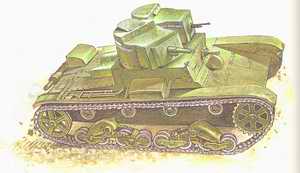 |
T-26M33 with mixed armament [2] |
 |
T-26 infantry supporting tank 1931 vintage, equipped with twin turrets. Tactical signs show that the vehicle belongs to the 2nd company of the 2nd battalion. Unidentified Tank Regiment, August-September 1941 [6] |
 |
Twin turret T-26 tank, 1931 model. The vehicle assigned to the Red Army's 21st Tank Division. Its hull shown in worn out condition with a few of the road wheels having been replaced with wheels from a later T-26 version. The tactical designations indicate that the tank belonged to the 1st Company of 1st Battalion. Northern Front,
Luga Operational Task Force, vicinity of the town of Soltsy, July 1941.[11] |
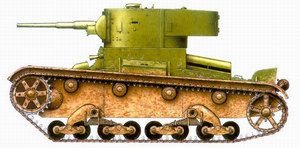 |
A T-26 model 1933 light tank assigned to an independent armoured battalion, 36th Motorized Rifle Division, of the Red Army. The Khalkhin-gol (Nomonhan) region, late July 1939.[12]
|
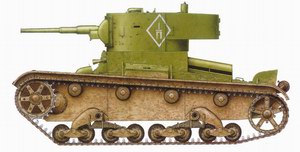 |
T-26 Mod. 1933 of the 24th Separate Tank Regiment. The Crimean Front, March 1942.[5] |
 |
T-26 tank (with additional armour plating) from the 5th Tank Brigade. Western Front, November 1941.[9] |
 |
T-26 tank from the 20th
Tank Brigade. Western Front, November 1941. [9] |


|
Different ways of displaying tactical numbers on turrets of T-26s. [13] |
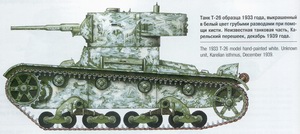 |
T-26 Mod. 1933 hand-painted with white winter camouflage. Unknown unit. Karelian Isthimus, December 1939 [13] |
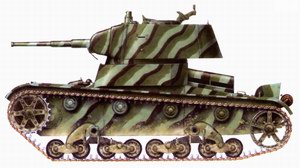 |
T-26 tank of model 1939, (most probably) belonging to the 18th Tank Division of the Red Army's 7th Mechanized Corps. Byelorussia, early July 1941. [10] |
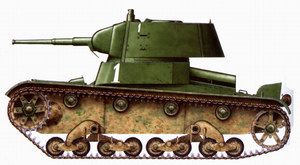 |
Light infantry support tank T-26 of model 1939 from the Red Army's 6th Mechanized Corps. Judging by the number "1" on the turret and on the box below the turret, this belonged to a battalion commander. Byelorussia, June 1941.[10] |
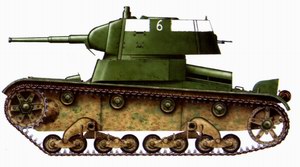 |
Light tank T-26 of the 1939 model evidently belonging to the 39th Tank Division of the Red Army's 16th Mechanized Corps. Vicinity of Uman, early August 1941.[7] |
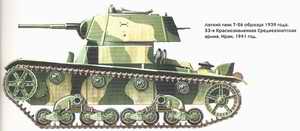 |
T-26 Mod. 1939. The 53rd Middle Asian Army. Iran, 1941 [4] |
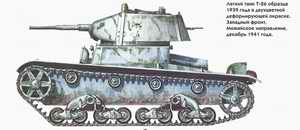 |
T-26 Mod. 1939 light tank in two-tone winter camouflage colours. Western Front, Mozhaisk direction, December, 1941.[4] |
 |
T-26 Mod. 1939. The 34th Tank Division/8th Mechanised Corps. South-Western Front. Summer 1941 [4] |
 |
T-26 Mod. 1939. It has tri-tone camouflage and tactical marking (continuous white strap - the 2nd company, broken white strap - the 2nd platoon), which had no use in 1941. The Crimean Front, the 55th Tank Brigade, March 1942 [5]
|
 |
T-26 Mod. 1938. Equipped with searchlights for night combat and tricolor camouflage. There is also a white cross air identification sign on the turret roof. The 56th Tank Brigade of the Crimean Front, March 1942 [5] |
 |
A T-26 mod. 1938 tank
assigned to the 6th Tank Brigade. South-Eastern Front, August
1942 [8] |
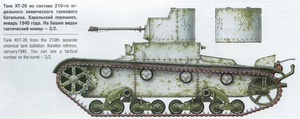 |
KhT-26 from the 210th Separate Chemical Tank Battalion. Karelian isthmus, January 1940. Note the tactical number 3/2 on turret [13] |
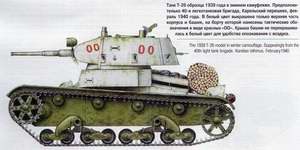 |
T-26 Mod. 1939 in winter camouflage. Conceivably the 40th Light Tank Brigade. Karelian Isthmus, Feb. 1940. Turret roof have no winter camouflage for air recognition [13] |
 |
KhT-26 (OT-26) flame thrower tank [1] |
 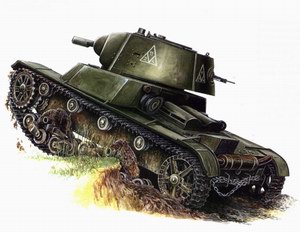 |
OT-133 (KhT-133) flamethrower tank operated by the 37th Army units. Inside the triangular tactical symbol are figures identifying the company number ("2"), platoon number (“4”) and the original tank number in the battalion (“13”) of the flamethrower battalion, in the vicinity of Kiev, September, 1941. [3, 7] |
 |
Remote controlled TT-26 tank from the 217th Separate Chemical Tank Battalion. This tank was hit in the vicinity of hill 65.5 in January 1940. Note that tank is not painted white and has autumn camouflage [13] |